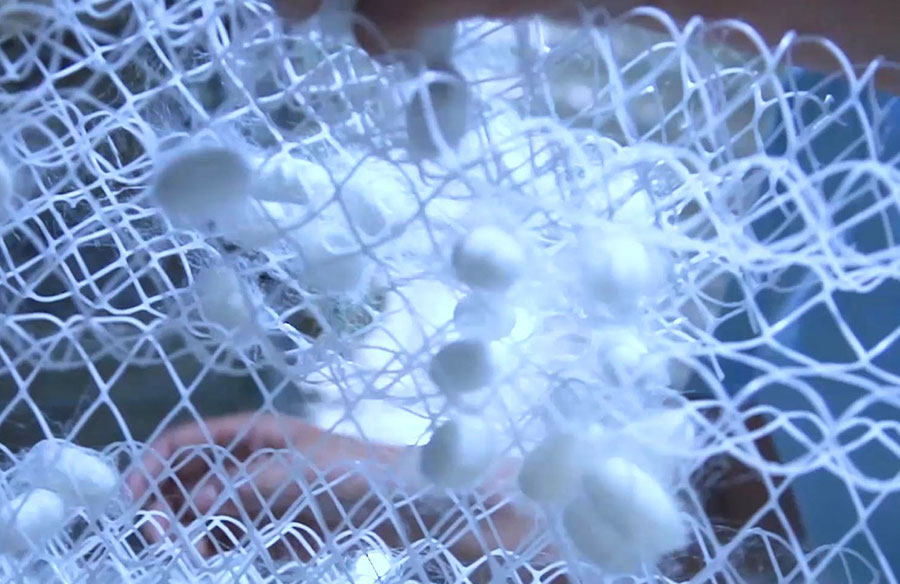

There is a Chinese saying that is literally translated as “Above there is heaven, down here there are Su and Hang", praising the legendary beauty of the cities of Suzhou and Hangzhou in east China’s Jiangsu and Zhejiang provinces.
The old saying has been proven right time and time again throughout history as their beauty continues to lure tourists from all over the world.
Zhenze town, located in Suzhou's Wujiang district, lies between the cities of Suzhou and Hangzhou. The town is home to important waterfront architecture and has built a reputation for its fish, rice and silk industries over the past 1,200 years.
Silk is a gift to the world from Zhenze ancient town, the birthplace of sericulture. Every year, a silkworm festival is held here to wish for a good silkworm cocoon harvest and promote the development of local sericulture.

Cocoons ready to be harvested (photo/ provided by Taihu Snow Silk Cultural Park)
Zhenze town has ramped up efforts to boost the integrated development of sericulture, the silk textile industry and cultural tourism, and is working to explore new approaches to promote its high-quality development.
Zhenze has launched a new all-in-one tour route which offers a unique culture and local life experience. Tourists can experience the handicraft of tie-dyeing, make bookmarks out of mulberry leaves at the Taihu Snow Silk Culture Park in the morning and then take a small train to enjoy the idyllic scenery of the ancient town in the afternoon.
Taihu Snow Silk Cultural Park, located in Zhenze, is China’s first characteristic industrial park built on the theme of sericulture culture, integrating agricultural demonstration, sericulture research, cultural leisure, popular science displays and eco-tourism.
At this cultural park, visitors can see the entire process of creating silk products, which starts at the Silkworm Breeding Demonstration Room. In this area, silkworms, which mainly feed on mulberry leaves, are separated according to their stage of development, starting from newborns, those that have changed their skin and the adult stages, when they start to build their cocoon.
Harvesting of silk begins at the stage when the worm starts pupating in its cocoon. If the worm is left to survive after spinning its cocoon, the enzymes produced could destroy the silk and cause the fiber to break down.
For 1 kg of silk to be produced, around 3,000 to 3,500 cocoons are needed with approximately 70 kg of mulberry leaves needed to feed to silkworms.
Since the 1980s, the benefits derived from mulberry planting and sericulture have declined, prompting silkworm farmers to seek other jobs. However, for ten years, local government has been working hard to create a “New Silk Road”, integrating sericulture, home silk textile production and cultural tourism related to sericulture. In 2019, Zhenze’s silk industry sales reached 1.6 billion yuan.

 Award-winning photos show poverty reduction achievements in NE China's Jilin province
Award-winning photos show poverty reduction achievements in NE China's Jilin province People dance to greet advent of New Year in Ameiqituo Town, Guizhou
People dance to greet advent of New Year in Ameiqituo Town, Guizhou Fire brigade in Shanghai holds group wedding
Fire brigade in Shanghai holds group wedding Tourists enjoy ice sculptures in Datan Town, north China
Tourists enjoy ice sculptures in Datan Town, north China Sunset scenery of Dayan Pagoda in Xi'an
Sunset scenery of Dayan Pagoda in Xi'an Tourists have fun at scenic spot in Nanlong Town, NW China
Tourists have fun at scenic spot in Nanlong Town, NW China Harbin attracts tourists by making best use of ice in winter
Harbin attracts tourists by making best use of ice in winter In pics: FIS Alpine Ski Women's World Cup Slalom
In pics: FIS Alpine Ski Women's World Cup Slalom Black-necked cranes rest at reservoir in Lhunzhub County, Lhasa
Black-necked cranes rest at reservoir in Lhunzhub County, Lhasa China's FAST telescope will be available to foreign scientists in April
China's FAST telescope will be available to foreign scientists in April